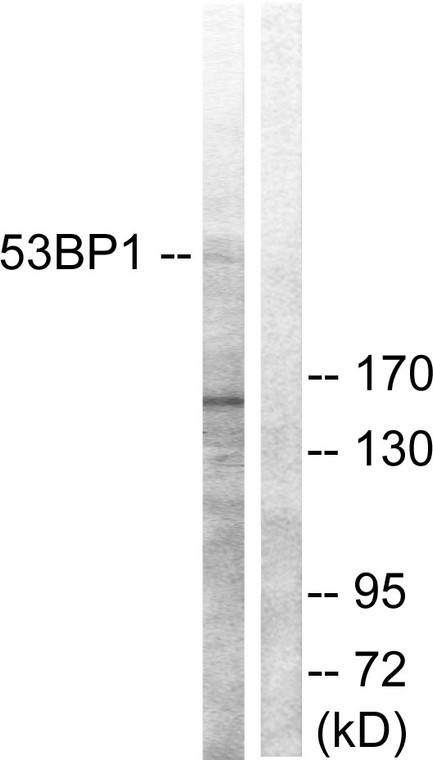| Host: |
Rabbit |
| Applications: |
WB/IHC/IF/ELISA |
| Reactivity: |
Human/Mouse/Rat |
| Note: |
STRICTLY FOR FURTHER SCIENTIFIC RESEARCH USE ONLY (RUO). MUST NOT TO BE USED IN DIAGNOSTIC OR THERAPEUTIC APPLICATIONS. |
| Short Description: |
Rabbit polyclonal antibody anti-TP53-binding protein 1 (1-50 aa) is suitable for use in Western Blot, Immunohistochemistry, Immunofluorescence and ELISA research applications. |
| Clonality: |
Polyclonal |
| Conjugation: |
Unconjugated |
| Isotype: |
IgG |
| Formulation: |
Liquid in PBS containing 50% Glycerol, 0.5% BSA and 0.02% Sodium Azide. |
| Purification: |
The antibody was affinity-purified from rabbit antiserum by affinity-chromatography using epitope-specific immunogen. |
| Concentration: |
1 mg/mL |
| Dilution Range: |
WB 1:500-1:2000IHC 1:100-1:300IF 1:200-1:1000ELISA 1:10000 |
| Storage Instruction: |
Store at-20°C for up to 1 year from the date of receipt, and avoid repeat freeze-thaw cycles. |
| Gene Symbol: |
TP53BP1 |
| Gene ID: |
7158 |
| Uniprot ID: |
TP53B_HUMAN |
| Immunogen Region: |
1-50 aa |
| Specificity: |
53BP1 Polyclonal Antibody detects endogenous levels of 53BP1 protein. |
| Immunogen: |
The antiserum was produced against synthesized peptide derived from the human 53BP1 at the amino acid range 1-50 |
| Function | Double-strand break (DSB) repair protein involved in response to DNA damage, telomere dynamics and class-switch recombination (CSR) during antibody genesis. Plays a key role in the repair of double-strand DNA breaks (DSBs) in response to DNA damage by promoting non-homologous end joining (NHEJ)-mediated repair of DSBs and specifically counteracting the function of the homologous recombination (HR) repair protein BRCA1. In response to DSBs, phosphorylation by ATM promotes interaction with RIF1 and dissociation from NUDT16L1/TIRR, leading to recruitment to DSBs sites. Recruited to DSBs sites by recognizing and binding histone H2A monoubiquitinated at 'Lys-15' (H2AK15Ub) and histone H4 dimethylated at 'Lys-20' (H4K20me2), two histone marks that are present at DSBs sites. Required for immunoglobulin class-switch recombination (CSR) during antibody genesis, a process that involves the generation of DNA DSBs. Participates in the repair and the orientation of the broken DNA ends during CSR. In contrast, it is not required for classic NHEJ and V(D)J recombination. Promotes NHEJ of dysfunctional telomeres via interaction with PAXIP1. |
| Protein Name | Tp53-Binding Protein 153bp1P53-Binding Protein 1P53bp1 |
| Database Links | Reactome: R-HSA-3232118Reactome: R-HSA-5693565Reactome: R-HSA-5693571Reactome: R-HSA-5693607Reactome: R-HSA-69473 |
| Cellular Localisation | NucleusChromosomeCentromereKinetochoreLocalizes To The Nucleus In Absence Of Dna DamageFollowing Dna DamageRecruited To Sites Of Dna DamageSuch As Double Stand Breaks (Dsbs): Recognizes And Binds Histone H2a Monoubiquitinated At 'Lys-15' (H2ak15ub) And Histone H4 Dimethylated At 'Lys-20' (H4k20me2)Two Histone Marks That Are Present At Dsbs SitesAssociated With Kinetochores During Mitosis |
| Alternative Antibody Names | Anti-Tp53-Binding Protein 1 antibodyAnti-53bp1 antibodyAnti-P53-Binding Protein 1 antibodyAnti-P53bp1 antibodyAnti-TP53BP1 antibody |
Information sourced from Uniprot.org
12 months for antibodies. 6 months for ELISA Kits. Please see website T&Cs for further guidance









